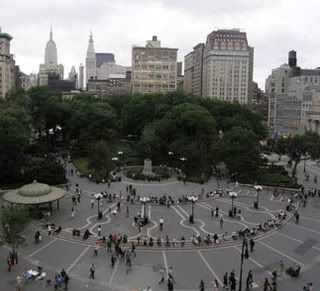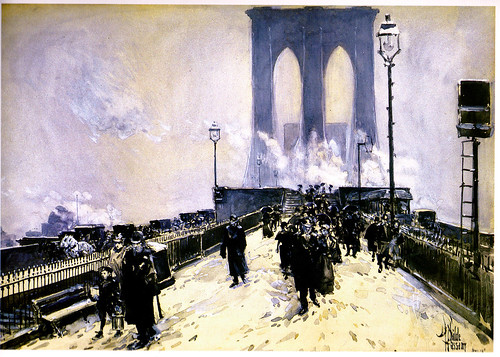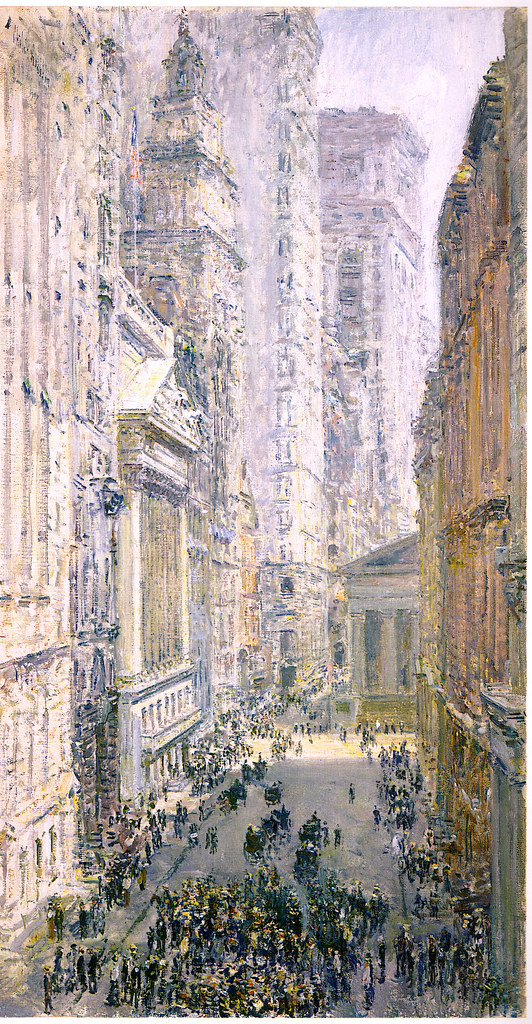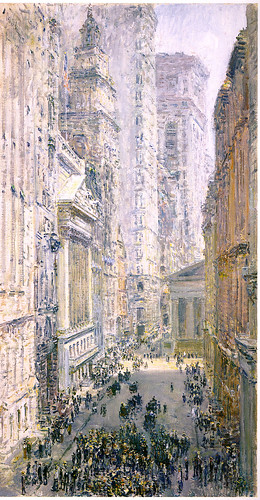Hassam’s New York - Arielle Algarin
I chose to visit the Broad Street location of Hassam’s painting for this assignment because it looked so different from the Wall Street area I am familiar with. My aunt worked in this area for quite a while and I spent a lot of time around Wall Street. The painting portrays the Financial District with such light and natural colors that it seemed almost foreign to me except for the recognizable stock exchange building. When I was able to visit this area for this project, unfortunately it was at a much different time of day then when Hassam created this work. The painting seems to be during the early day, with the sun almost impossibly bright. My photograph is from twilight, at the end of the day and the area surrounding Wall and Broad street has had so much development that hardly any light reaches the street. It is so dark on the street that the street lamps are already turned on, despite the sun clearly still being out. It would be almost impossible to recreate the perspective that Hassam has without being on top of another building at the exact same angle. But the same hustle of people still exists on Broad street, but I feel as if the painting and the photo are depicting two very different energies, Hassam painted what seems like a much more “relaxed” Wall/Broad street. The two pictures represent very different time periods and almost seem to be different places, but the famous buildings and groups of people tie the two depictions together.
Union Square 2- Mya Marshall
I chose to replicate Union Square 2 by Hassam.

I decided that I wanted to choose a painting of Union Square since I have so many memories there, and at one point in my life I regarded it as somewhat my second home. Considering my long history with the park, I figured that it would be easier for me to figure out where exactly the painting was created, whereas it would have been a lot more difficult in a place unfamiliar to me.
I found the picture a little harder to replicate than I had expected. It seems that Hassam was at a higher angle than I was while painting his picture, as his painting depicts a more bird’s eye view of the park. I could only get as high as the top floor in Filene’s Basement across the street. Also, looking at the perspective and vantage point of the painting, I noticed that the painting was at an off-center angle, while my photograph is at a more centered angle. In addition, the park has gone through so many changes and renovations over the years, causing it to look very different from today. The patches of grass are in different areas and broken up at different spots. It is difficult to see the patches of grass in my photograph, because of the density of the trees, and the increased number of them.
At first I thought that Hassam’s painting was done a little later in the year, as the foliage on the trees is sparse, while in my photograph the trees are still full of leaves, but still having the shades of fall. Then I realized that the color of the grass and remaining leaves on the trees seems more like the color of new growth in spring. The time of day appears to be the same, but my photograph appears to have been taken on a rainier day, as the lighting in Hassam’s painting is bright and sunnier, as opposed to my picture, which is a lot grayer.
bethesda fountain-steve chu
For some reason or another, this link :http://www.mcny.org/shop/76/202/7865/bethesda-fountain-central-park.html
was posted among the other pictures with the Hassam assignment. Not knowing any better and figuring it was the closest thing to school, I attempted to take a photo of the Bethesda Fountain in Central Park in the same position that this original photo was taken. The original photograph was taken by H.L. Wittemann during the 1930s. I attempted to be in the exact position that he must’ve taken the photo but was unable to for several reasons. The first being my use of my laptop as a camera and the difficulty in trying to take a picture simply by holding my computer in my hands so i set it down on a part of the terrace facing the fountain. I also found the ideal point obstructed by a high reaching peace of the terrace. I would’ve liked to back up for a better angle but would’ve found myself in the middle of the road,or even further which would’ve placed me on a hill, so i settled for the terrace. The view of the two buildings in the upper left corner is quite clear in the original but due to the high reachign trees of the present as well as the poor lighting condition i found that day, they simply appear as white streaks in my replication. There was also my inability to see the view through the lenses without being in the grass, where i was not supposed to be. I did my best in attempting to replicate this picture, and at the very least my version has color and beautiful fall leaves.
Winter in Union Square
What I first noticed about the painting was the weather. I don’t have much to say about that, other than that I’m not looking forward to meteorological history repeating itself this year (I thank God every winter for global warming… evidently he answers the prayers of American evangelicals who think climate change is “cyclical”). The second thing I noticed, though, were the horse-drawn buggies. I have plenty to say about that, and none of it political (except the parentheticals).
To me, the notion of New York without awful public transportation is as foreign as the notion of cause without effect (like, say, carbon emissions without rising global temperatures). But once upon a time, Union Square had horse drawn buggies! Buildings, a nice big stone church, no skyscrapers just yet but still, signs of advanced civilization… and horse drawn buggies! Today, it is where I transfer to the Q to Brooklyn, or the 6 to the Honors dorms, or the L to 1st avenue (more scenic route to the Honors dorms; I believe it’s faster as well), or the 4 and 5 on those rare occasions when I have somewhere to go uptown that isn’t Hunter college. All of which are miserable, crowded, airless rides on tracks with mechanical signals from the 1920’s. But once upon a time, New Yorkers got around on horses and buggies. On the one hand, it makes me thankful for speedy mass transit. On the other hand, I wouldn’t mind some fresh (less polluted) air on my next trip uptown. For that, I envy Hassam.
(side note: his horse drawn buggies and trollies predate our mechanical train signals by only thirty years. And this painting was painted in 1890. I think Benjamin Harrison was president! Is it not time for an upgrade?!)
Union Square 2-Jacqueline Leon


The picture that I chose to replicate was the Union Square 2 one mainly because it was closest to the school and on one of my breaks, I decided to head there to take an easy snapshot. It was not that hard a picture to take considering that there is a mall standing right in front of the Union Square Park. It is quite evident that Hassam’s picture was created some time ago because there are less trees in his picture as well as less tall buildings and people surrounding the park. The view is a lot alike but not quite exactly the same. My picture is taken now in fall while Hassam’s was taken during spring since the color of the leaves are yellow. There were less people around in the park when he decided to paint his piece. Also the angle at which he made his painting at was different compared to my snapshot. He must have been at a location that was to the left of where I was because my picture is more centered and his is not. Union Square 2 was a good and somewhat easy choice of picture to try to replicate because of the position, which Hassam decided to paint. On the other side of the park, there was construction and the park would look unappealing in the picture that I would have taken. The Starbucks on the other side was also very crowded and I couldn’t seem to take a picture from there either because the sun was too strong and people were drinking coffee near the windows. Technology and modernization throughout the years makes the park a different environment. Hassam has made a nice painting that is ephemeral in the sense that it hard to exactly duplicate but getting to know the city a little better through art made it a fun experience.
Hassam NYC Joel Kaplan
I chose Hassam’s Winter In Union Square (1892) because it relates in part to my group topic, symbolism and iconography. Hassam’s paintings depict a period of immense change and transition in NYC. Buildings began to rise and a skyline of unprecedented height began forming during the early 1900s. Prior to the use of steel in forming the backbone of our skyscrapers, stone was used in the tallest structures, which were always the gothic churches and religious buildings. In Winter in Union Square, the faint spire of Trinity church can be seen in the deep background through the clouds and haze of downtown Manhattan. To the right of the church is the Domestic Sewing Machine Company, which appears taller and broader, and dominates the view. The bright blue and red trolleys in the foreground (notice they are horse-drawn trolleys) form a trail across the canvas, not in any way oriented with regard to the spire, but only momentarily beneath it.
The meaning of this arrangement is fairly obvious: the power and influence of the church is waning and fading, its role in the lives of urbanites soon to disappear among the rising structures of commerce and modernity. Regarding the painterly technique used, I cannot note much except that Hassam’s brush strokes seem to work best when weather affects the image; snow and rain allow for the blurred definition that Hassam achieves in much of his painting.
P.S. - My Flip isn’t working right, I can’t seem to transfer video, so unfortunately I don’t have the comparison image.
Hassam’s New York-Broad Street


Above are pictures of modern day Broad Street.
Hassam’s Original Painting.
There are quite a few differences between my photo and Hassam’s painting. The most obvious being the angle and perspective differences. In Hassam’s painting, he was probably perched in a building so as to create the omniscient feeling of being able to watch the activities below. I was unable to do that so my photo is from the perspective of one the people on the street in the painting. It was also difficult to mimic the distance from which the original was made due to various lights and vans obstructing the view.Now the NYSE is pimped out with American flags, which now cover the columns, in commemoration of September 11th. But i was able to reconstruct the image of both the NYSE and Federal Hall as well as the skyline, although that has gotten a little taller in the past century. The whole area of Wall Street has an old world air because many of the original structures remain, however, in my photo all of the buildings, except the NYSE and Federal Hall, are newly constructed and more modern.
Mikaela Murph
The Brooklyn Bridge by Jin Woo Chung

Above are two pictures of New York’s great tourist attraction, the Brooklyn Bridge. Considered an amazing feat of engineering during its times, the Bridge is depicted in Hassam’s painting not too long after its construction. Being an impressionist, Hassam depicts the Bridge as a huge, foreboding monolith in the back in the cold day as men, women and children make their way from it. The vanishing point is obvious as the linear perspectives centers on the bridge itself. The eerie smoke and hazy outlook gives the picture an ephemeral appearance.
In contrast to Hassam’s painting stands the good ol’ photo I took last week. Unlike Hassam’s, the Bridge here looks inviting and social, as people stand around it to talk or people just jog along it for some exercise. In the background can be seen the Brooklyn skyline, illustrating the modernity of the setting. The vanishing point is once again centered on the bridge and is the visual, realistic snapshot of the actual bridge.
Both these pictures showcase the Brooklyn Bridge, but Hassan’s makes his depiction of it quite cold and distant, while my photo of it shows it as a nice, inviting place for tourists around the world to gather and enjoy the site. Oh my! How New York has changed, hurry for gentrification and commercial tourism!!!
The Brooklyn Bridge - Alexander Schinis
Bridges — while New York City has many of them, the Brooklyn Bridge stands out from amongst them as an almost iconic symbol of the City. Above are seen two different pictures of the bridge, the first as it is depcited by artist Childe Hassam and the following being a picture of the actual modern day bridge. Both representations were produced from nearly the same viewpoint, and we can see that both bridges are nearly identical, with a few exceptions.
As seen in Hassam’s painting, the Bridge itself is more simple, yet more austere, than the modern bridge. It seems to loom in the background, wreathed in fog, appearing to be simple, powerful, and even cold. Hassam captured, too, the hustle and bustle of the bridge crossing folk, but as we can see, he gave them no faces and did not fill them with color; rather, we see the forms of people, somewhat indistinct, passing onward to their unknown destinations. The artist seems to be making a statement about the nature of the city that the bridge is located in.
Conversely, in the modern photograph, we see the bridge bathed in sunlight on a beautiful sunny day. There is foot traffic on the bridge, but the faces are clearly shown, and the people in the picture are wearing color as opposed to the black and gray of Hassam’s painting. The viewer can see some clear discrepancies between the two.
What can be inferred from this? To me, it seems clear: New York City has changed since Hassam’s time, from a rather grim, uninviting city to what many consider to be the very capitol of the world itself.
Broad Street Theresa Raniolo
I find this particular painting of Broad Street very interesting because of its specific location. Examining Broad Street the other day, I discovered that it runs north to south and then bends toward the East River. Hassam was situated at an elevated location right where Broad Street bends looking north toward Wall Street when he painted this. His location gave him a clear view of not only the street and masses of New Yorkers, but also of the Stock Exchange, the financial capitol of the world, and of Federal Hall, the first capitol of our nation. The direction of the crowd seems to be headed north toward Federal Hall, drawing our eye up the street to the historic site framed by the two rows of skyscrapers. Our eye is also generally drawn to the vanishing point of a painting; this painting’s vanishing point lies behind Federal Hall.
It was no accident that Hassam chose this particular setting to paint. It juxtaposes historical New York with modern New York, New York’s rich past, symbolized by Federal Hall and the wealth of ideals of the founding fathers, with its richer present, symbolized by Wall Street and physical wealth. There is certainly artistry in this painting since Hassam probably exercised artistic license when he painted the crowds, all moving in the same direction and concentrated at the bottom of his composition. The way he uses shadow and light also highlights the two buildings that are his focal points, and gives your eye a path to follow when looking at the painting.
Broad Street was closed for a rally when I took the picture on the left, so I was able to stand in the street before the bend; I was unable to get a picture from a higher point looking down on the street as Hassam painted from, but you can still see Federal Hall and the Stock Exhange on the left, draped in the American flag.









